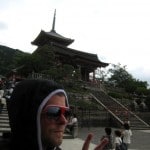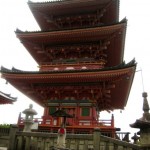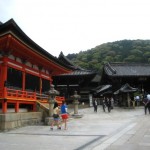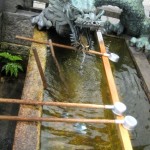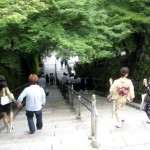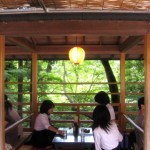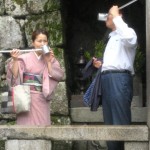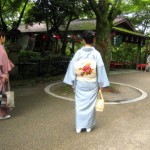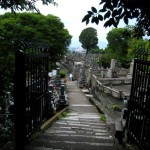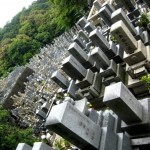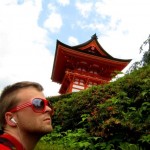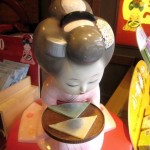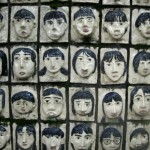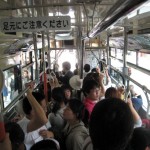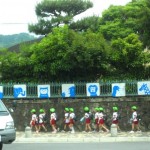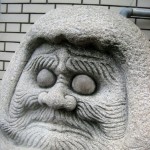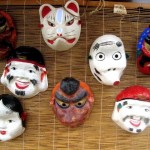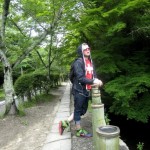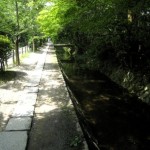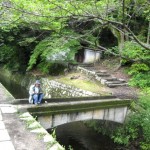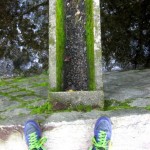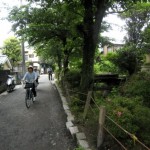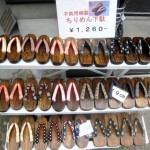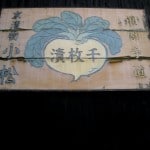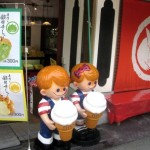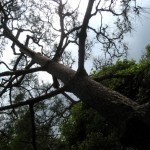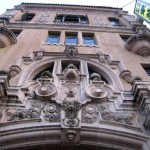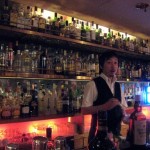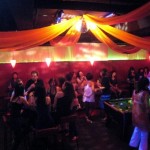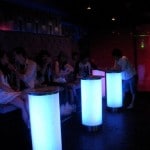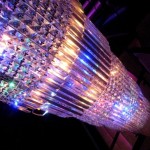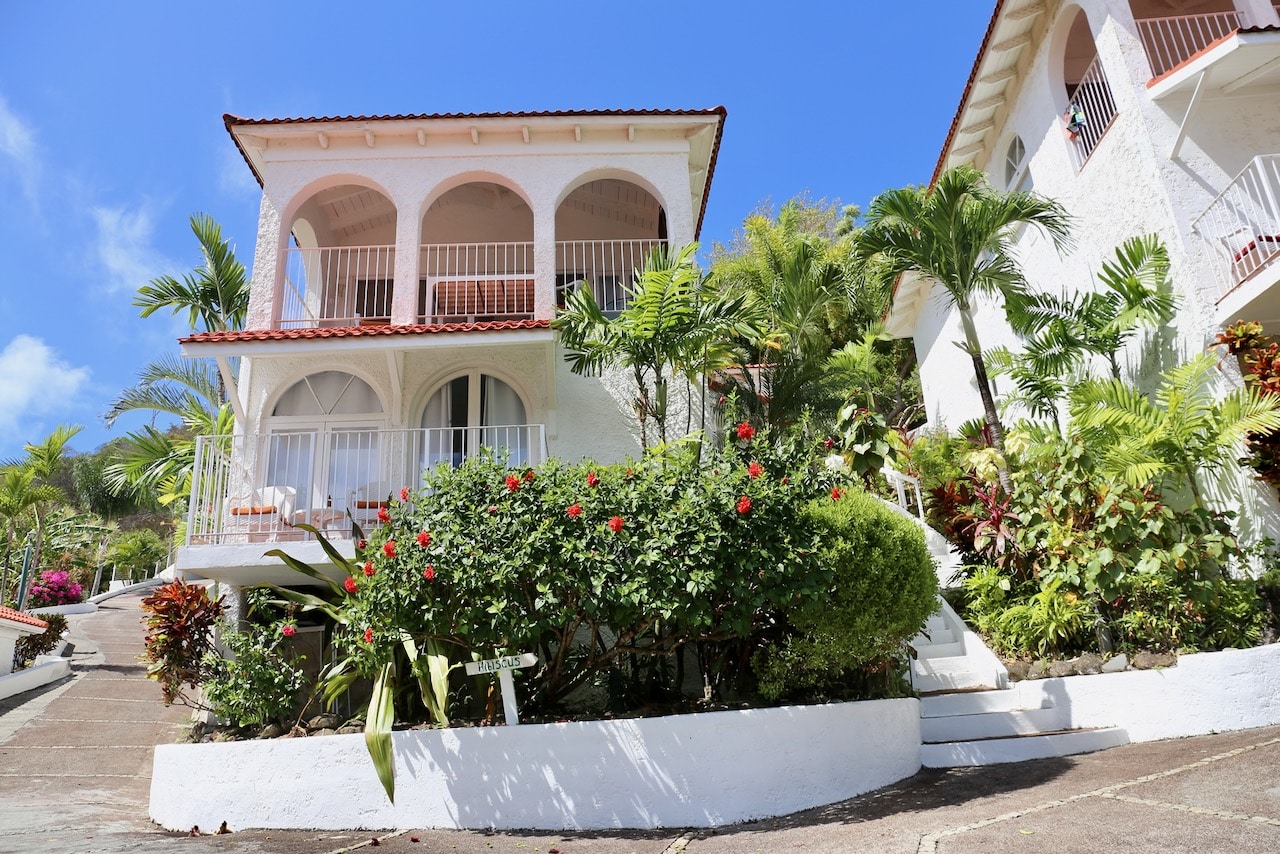I was elated in the morning when I realized there was not a cloud in the sky. I hopped on the subway and headed to the east end of the city. I arrived at another insanely packed tourist street full of corny trinkets and Green Tea Ice Cream shops. The most famous landmarks in this city are always preceded by a 200 meter congested shopping arcade.
Kiyomizu-dera is one of the oldest temples in Kyoto and dates back to 798. The temple takes its name from the waterfall within the complex, which runs off the nearby hills. Kiyomizu means pure water. It is notable for its vast veranda, supported by hundreds of pillars, that jut over the hillside and offers impressive views of the city. The popular expression “to jump off the stage at Kiyomizu” is the Japanese equivalent of the English expression “to take the plunge.” This refers to an Edo period tradition that held that, if one were to survive jumping from the stage, one’s wish would be granted. Two hundred and thirty-four jumps were recorded in the Edo period and, of those, 85.4% survived. Jumping is now prohibited (thank goodness).
Beneath the main hall is the waterfall Otowa no taki, where three channels of water drop into a pond. Visitors to the temple collect the water, which is believed to have therapeutic properties, from the waterfall in metal cups attached to poles. It is said that drinking the water of the three streams confers wisdom, health and longevity. One Australian tourist who I was standing beside muttered, “we should bottle this stuff and send it to everyone working at the Bush Administration.” Some Japanese believe that you must choose only two – if you are greedy and drink from all three, you invite misfortune upon yourself.
The temple complex contains several other shrines, notably Jishu-jinga, dedicated to the god of love and good matches. Jishu-jinga possesses a pair of love stones placed eighteen meters apart, which lonely visitors attempt to walk between with their eyes closed. Success in reaching the other stone, eyes closed, is taken as a presage that the pilgrim will find love.
The complex also includes all the fixtures of a popular temple, being one of the most visited attractions of the city: hawkers offering various talismans, incense, and omikuji (paper fortunes ranging from “great blessing” to “great curse”) abound. The temple is also a particular haven for students wishing for the aid of deities in graduation, and is well known for having trees whose branches are covered with paper wishes tied there by the hopeful.
I spent around an hour walking through Kiyomizu-dera and tried to imagine living here in peace and quiet a thousand years ago. It is hard to imagine this secluded temple being a place of solitary contemplation as tourists run this roust now. The Japanese do an amazing job at building peaceful places within their mountain forests and tranquil gardens while still located in a bustling city. I often forget that I am living in a city of over three million people while strolling through these ancient temples and shrines.
On the western border of the complex there are several noodle restaurants perched on the edge of cliffs and nestled in the forest, which provide an amazing view. I stared at several school girls sitting on an open deck gobbling down bowls of udon entirely surrounded by cherry trees, firs and maples. As I walked back down the tourist shopping avenue I took a quick left down a side street and found an adorable fine dining noodle restaurant located amongst a Buddhist rock garden with a spectacular view over the forest.
I was seated on a glassed in porch with a towering stone Buddha standing in the garden to my right. I ordered a large bottle of Asahi Beer and nibbled on wasabi dusted rice crackers before my cool ceramic bowl arrived. I stared down at the contents of my bowl and my heart fluttered as I stared down at my edible art piece. A foot long succulent shrimp tempura sat atop a cold tower of soba buckwheat noodles which had been tossed in a sweet soy broth and sprinkled with scallions and rice puffs.
After my delicious lunch I stepped out into the sun filled rock garden and climbed down a steep path. I came across a hidden cemetery which proved to be a true gem. The cemetery is located across several hill tops and is surrounded by tall pine forests on all sides. I took some spectacular shots before grabbing a bus a few kilometers north.
I arrived at the entrance of the cities famed Philosopher’s Walk. This scenic and quiet river side stroll is flanked on both sides by towering cherry trees which create a tunnel of branches as you walk up the path. It derives its name because Japanese philosopher, Kitaro Nishida, used to walk the two kilometer path to meditate. The stream reminded me of the river I was somewhat enchanted with in Edinburgh a few years ago. Long strands of aquatic plant life tossed in the river as I waved to a group of geriatric bicyclists. The stream has many little cafes and antique shops on the left side of the street whereas the right is where you will find numerous shrines and temples. As if Kyoto didn’t have enough ancient buildings…one always finds another.
I talked with a few high school students at the bus stop (who told me with a very serious tone in their voice that I was the most beautiful person they had ever met). I arrived at Gion corner with plenty of time to set up camp and prepare my Geisha-dar for some serious geiko paparazzi moments.
Arriving an hour earlier than the crowds I was able to assess the rather top secret lives of these artists. I sat on a stoop and within a span of seconds a black taxi drove up to the entrance of the tea house across from me. The driver opened the cars doors and a set of two glamorous geisha’s ran into the back seat. This happened several times within the next ten minutes. Each tea house had a business woman who would sit in the front seat and direct the driver. I was astonished by the quick and quiet manner this all happened.
Watching the body language and gestures of the drivers it was evident that locals hold a great deal of respect for these entertainers. Geisha represent a very different time in Japan’s history and since this art form is dying it seems as though patriots treat these woman almost as if they were saints. Japanese tourists always have a huge smile across their faces when they encounter a geisha on the street and they repeatedly bow in front of them until their backs hurt. It seems as though there is a sort of magic in the air when you are in their presence.
I was the only person on the street as these mysterious pick ups occurred. A few minutes later the streets filled with more taxis, this time however they were full of business men dressed in suits. Surely heading to a geisha show for entertainment, food, drink and a hefty bill to boot. The tourists started to arrive with their tripods and massive cameras about one hour after I had initially arrived.
I spotted a wildly dressed guy wearing huge Nike Dunks and snapping away with his professional Nikon. You know those moments in life when you get a sort of fuzzy feeling and feel the need to follow someone? Well I got this fuzzy feeling which was surely my Geisha-dar. We stood at a small intersection off the main street and introduced ourselves. He had lived in Whistler for the past few years and hales from Sydney Australia. We both decided to guard the intersection and inform the other when we spotted something.
And then, all of a sudden, I screamed, “it’s a Geisha!” He whipped around and we started to madly shoot this woman with our cameras as she elegantly walked down the cobbled street in her pink kimono. I thought I had died and gone to heaven. She quietly said, “konichiwa” and stopped at the intersection to talk to an old local man walking his bicycle. I blurted out, “can I take a picture with you?” She nodded yes, and we both acted like the most loathsome tourists for the next minute as our old granddaddy from Japan snapped our pictures with her. If that wasn’t fantastic enough. Another geisha (who I assume she was waiting for) rounded the corner. Two geisha now stood in front of me standing and bowing and smiling and being delightful. They both turned and headed towards the main street where a hoard of unknowing tourists thirstily waited for their appearance. We chased them down the street as they lifted up their kimono and darted for the business woman who quickly ushered them into her tea house. My heart was racing and we both decided to sit down as we were on a bit of a high from the whole experience. Very few people get to see and interact with geisha up close like I had moments earlier. Geisha typically run along the street and avoid talking to tourists as they are basically running to work and don’t have time to stop and chat. My Geisha-dar was clearly a valuable asset today!
I skipped back to the hostel with a huge smile on my face and immediately showed everyone on the balcony my amazing pictures which made them infuriatingly jealous of me. A group of us headed out after dark to discover the Kyoto nightlife offerings. We first stopped into a little local pub called Club Voodoo. I felt as though I was in an episode of the Japanese version of Cheers. I told the bartender my life story over a glass of Baileys on the rocks. I then chatted with a really fat man sipping on whisky who told me in broken English, “everyone thinks I am a sumo because I am obese.” He then hysterically laughed which in turn caused me to giggle until my gut hurt. I think we also may have run into the local drunk. A twenty six year old who looked like the spitting image of the speed racer character from the famed manga film, Akira. He had a huge head of spiked hair, shiny red motorcycle jacket and seemed to only talk to us if we held up peace signs.
We then walked down the main night life street which seems to go on for miles. One of the locals who works at the hostel took us to a foreign friendly club. The first floor featured a large bar and a small dance floor with several Caucasian women who were desperately trying to dance in high heels. They clearly needed a lesson from their Japanese counterparts. Walking up a spiral staircase I stared up at the massive glowing glass chandelier which hung from the ceiling. On the top floor hundreds of “too cool for school” Japanese youth dressed to impress lounged on plush sofa’s which glowed a wild spectrum of neon. I ran into my Australian Geisha-dar photography friend on the dance floor and spent the next hour or so having a blast with a wild assortment of Japanese youth.
